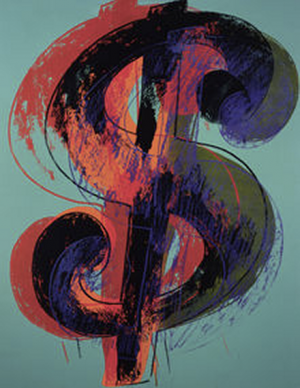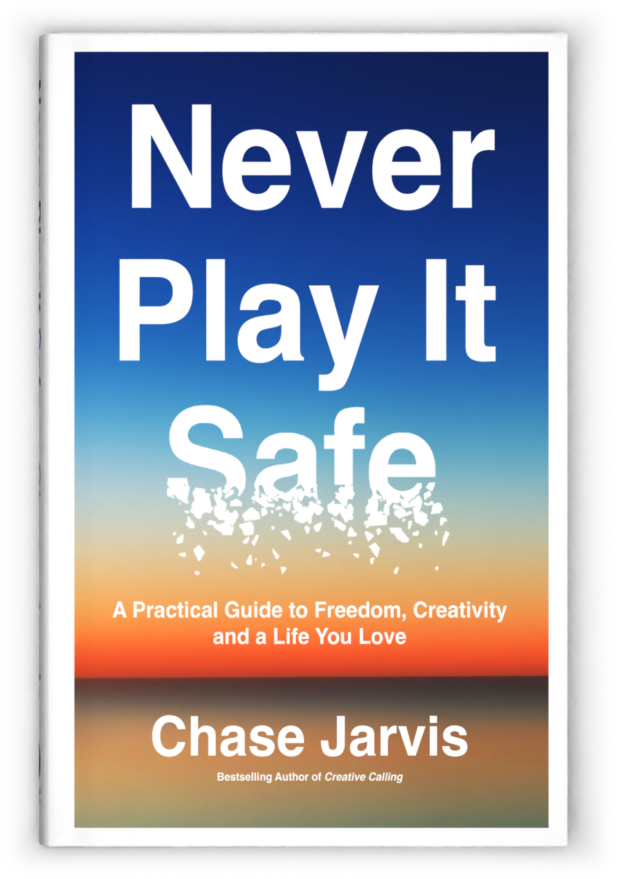
Dollar Sign - 1981
Total bs. The next time someone suggests that business has no place in art – or someone tells you that its a good idea to have a “backup” for your creative vision of making a living – recall the example of the most successful businessman in the history of art: Andy Warhol.
He famously said, “Being good in business is the most fascinating kind of art.” Warhol’s business was reportedly worth $700 Mil by the time of his death in 1987.
Warhol got his start selling product illustrations to advertisers and department stores. He was really good at it and achieved a high level of commercial success before he became a pop art icon by bending linear thoughts of consumerism into an artistic pretzel. He intentionally blurred the line between commerce and art. He was never afraid of business – he actually saw it as part of his art. And to that end – his art has proven to be very good business. In fact, according to the Economist his work accounted for 17% of all auction sales in 2010 for $313m. This was a 229% increase over 2009 sales and proved his art to be recession proof in a big way. The market for Warhol’s art has outperformed the Dow Jones growth in the past 25 years – by a long shot.
So is it a coincidence that the most successful businessman in the history of art actually saw the business itself as part of the art? Would he be surprised by this continued success and ROI for his collectors? Certainly not.
+++++++++++++++++++++++++++++++++++++++
This post was inspired by Seth Godin’s blog post here via @goodchemist
















I think you may have missed the point of Seth’s post entirely.
Lets ignore the fact that it says “conventional thinking” and “often”, meaning it’s not a blanket statement about every artist or every businessman.
If people click through to read the full post instead of just the opening paragraph, you’ll find the point Seth is making is that business can make great use of art and that great artists usually have the business side looked after too. His point is that people shouldn’t be afraid of the other side, instead they should embrace it.
I heard of a study where they filmed a bunch of people working together at solving a problem. Then they showed the movie to other people and asked them to evaluate the leadership skills and creativity of each person in the video. The result was that were scored highly as leaders were scored low on creativity and vice versa.
The conclusion they came to is that leaders seeks compromise to get the approbation of the whole team. This involves removing the risker and weirder elements from the work — that is, the most creative aspects. On the other hand, the most creative persons scored low on leadership because they didn’t compromise: they had a clear vision of what they wanted to achieve and didn’t really care for the opinion of skeptics.
So maybe the reason why artists dislike business so much and why businessmen distrust artists so much is that they require fundamentally different personality types to be successful.
I have always had difficulties in putting a price on the art I create, but after having been taken advantage of on more than one occasion I’ve learned to be more business like in my approach. Still, it’s a fine line between charging what you think you’re worth and what the market values you at. That is where actively working to increase my market value will pay off over time, and hopefully leave my work in high demand!
I don’t make art with the market in mind. I think Warhol did. His art was social commentary. My art isn’t. I can’t make art for a particular market. I worked as a graphic designer for many years. Instead of informing my art, it crushed me. I have to wear two hats when I market my art. When I talk to others about my work I have to be detached. It’s not such a comfortable mix for me.
Business, it’s how you become a successful artist. You just have to deal with it.